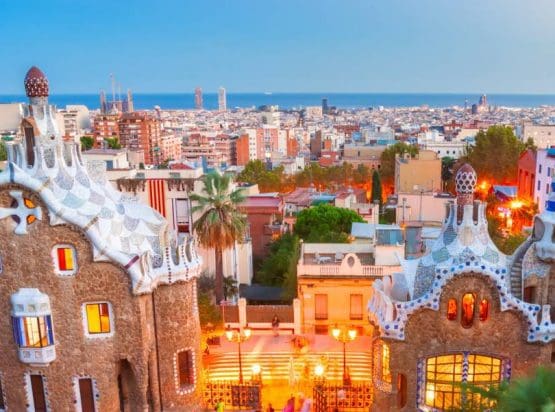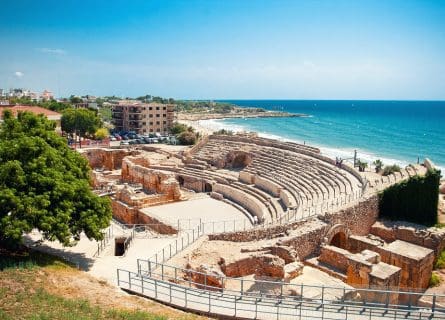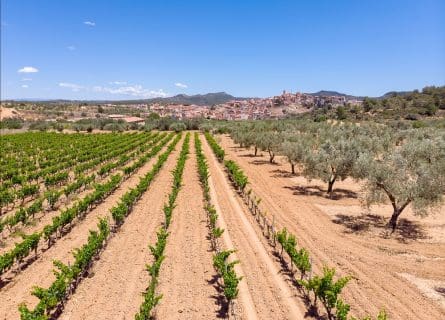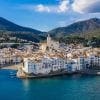Immerse yourself in Barcelona's vibrant flavors and uncover hidden culinary gems with our expert insider guides. Plan an unforgettable trip today!
Read more
EXPLORE ALL OUR CATALUNYA WINE REGIONS GUIDE
Last updated: October 22, 2024
The essence of Catalunya can be epitomized in a single word: diversity. This region is a kaleidoscope of varied terroirs and contrasting macroclimates, fostering remarkable adaptability in viticulture. Take, for instance, the rare phenomenon of Garnacha Tinta’s white sibling. Where else could it cultivate such a dedicated and robust following in the rugged hills of Terra Alta? One of Catalunya’s more obscure regions, it is located in a little piece of bucolic paradise to the south and west of Barcelona. Flanked by the spectacular Sierra de Pandols, producers work miracles with the Garnacha Blanc grape, squeezing every last drop of fruit and elegance out of this (unfairly) maligned variety. Terra Alta’s increasingly fine whites – and reds – are finally starting to tempt consumers outside Catalunya. Give them a chance, and you’ll be amazed.
Discover more about Spanish Wine

Travelers weary of the hustle and bustle inevitably discover a haven in Terra Alta, a place where serenity replaces crowds and chaos. Hidden in a blissfully unspoiled corner of northeastern Spain, the name means ‘high land’ in Catalan. The area has hosted some famous alumni over the years, including the artist Pablo Picasso. He spent a number of summers immortalizing Terra Alta in the 20th century, painting some exquisite landscapes.
Many centuries earlier, the Roman general Scipio first set foot on Spanish soil at Empúries on the Costa Brava, close to the French border. Scipio was planning to cut off the forces of Hannibal, leader of the Carthaginians. Emerging victorious, the Romans founded several important settlements, including Barcino (Barcelona) and Tarragona. Over time, viticulture spread across the Iberian Peninsula – Catalunya’s Mediterranean climate was ideally suited to wine growing. The Romans appeared here to stay.
Visigothic Turmoil
Yet, the empire began to wobble after more than five centuries of imperial rule. Indeed, it is no coincidence that the Roman walls in Barcelona went up in the 4th century AD. By the 5th century, anarchy ruled as the Western Roman Empire lost all authority over its dominions. The comparatively Romanised Visigoths established a capital in Toledo, announcing themselves as the new overlords of the Iberian Peninsula. With the assistance of Hispano-Roman nobility and Christian clergy, the Visigoths consolidated a fragile power base in central Spain.
However, their chaotic rule was precarious from the outset, not least due to constant infighting. This paved the way for an invasion in 711, spearheaded by the Muslim general Tariq. After assembling an alliance of Arab and Berber mercenaries, Tariq landed an expeditionary force of 7000 men at Gibraltar, quickly conquering Andalucia. By 718, Catalunya was a Muslim state.
In comparative terms, however, their reign did not last long. The Franks and local counts mounted counterattacks, retaking Girona in 785 and Barcelona in 801—a failed last-ditch effort to retake Barcelona in 985, undertaken by the feared general Al-Mansur. Catalunya went from strength to strength; under the direction of Ramon Berenguer III, the region launched its own fleet, and sea trade developed. One of his descendants, Ramon Berenguer IV, married Petronilla of Aragon in 1137.
After more than a century of exploration and conquest, this coalition included Valencia, the Balearic Islands, and Roussillon in France. But after Fernando (a descendant of Petronilla) married Isabel of Castile in the 15th century, Aragon and Catalunya were subsumed into the Castilian state. In retrospect, Ramon Berenguer IV’s decision to create political union via marriage must have seemed like a Trojan Horse!
Indeed, the region was sidelined as Castile marched from victory to victory; the Muslim stronghold of Granada was retaken in 1492. In the very year that Columbus reached the shores of the Bahamas, a new epoch began, setting in motion the extensive colonization of Central and South America. Unfortunately, Carlos I and his successor, Felipe II, squandered Castile’s golden opportunity. These Habsburg monarchs spent large amounts of gold on futile wars with their European neighbors instead of building new industries and developing Spain’s infrastructure. By the 17th century, the crown was in poor shape – Spain was bankrupt and destitute.
The situation improved in the late 18th century; however, trade with the Americas boomed with the advent of new industries in Catalunya. Yet the next two centuries saw an almost unending wave of political violence. By the early 1900s, Madrid had become known as the ‘city of bombs.’ Things came to a head in 1939 when the armed forces of Francisco Franco sought to overthrow the Second Spanish Republic. After years of bloody fighting, Franco installed himself as dictator in 1939. But even after his death and Spain’s transition to democracy in the 1970s, regions like Terra Alta were in a poor state. A combination of state-sponsored mediocrity and grower apathy damaged the reputation of Catalunya’s once-thriving wine industry.
Fortunately, the award of DO (appellation) status in 1985 led to improvements across the board in Terra Alta: lower yields, the rise of organic viticulture, and modern equipment have all contributed. Today, the DO is associated with pungent Garnacha-Blanc whites and exotic reds. Catalan sommeliers can’t get enough of it.

The vineyards of Terra Alta are situated in prime Catalan real estate: the foothills of the Sierra de Pandols provide endless variations in aspect and altitude. Indeed, site selection is a veritable religion in Terra Alta, with white varieties planted at higher elevations to preserve acidity in the berries; the warmer, lower areas are reserved for late-ripening grapes like Garnacha Tinta and Carineña. This takes place in a southwestern corner of Catalunya, near Aragon’s border. Most producers own wineries in Gandesa and Corbera d’Ebre towns, with vines carpeting the surrounding landscape. Today it remains one of Catalunya’s hidden gems – undiscovered by tourists and scarcely altered since the 19th century.
Climate Challenges and Terroir Benefits
Yet the climate can be off-putting. Winters are often bitterly cold – expect 23°F in January – and summers can peak at 104°F in July and August. Fortunately, growers can rely on the cooling influence of El Cierzo. This easterly dry wind originates in Rioja’s Ebro Valley, acting in unison with the cool nights that are a feature of Terra Alta’s higher vineyard sites. Meanwhile, The local terroir primarily comprises clay-limestone soil, offering good drainage and reasonable moisture retention – vital in the hotter months.
Terra Alta was once the butt of jokes in Spanish wine circles. Sloppy viticulture – and rustic winemaking- led to very unappealing wines, typically lacking fruit and freshness. However, modernization and real investment have uncorked the region’s vast potential; cool fermentations in stainless steel have become standard practice in the DO, while ambitious growers, often working with parcels of old bush vines, are committed to the quality path. As a result, relatively few poor or faulty wines are being made in Terra Alta today. That was certainly not the case 40 years ago.
Diversity and Tradition
According to the DO framework, red, rosé, and white wines can all be produced in Terra Alta from a broad palate of grape varieties. These include Garnacha Blanca and Garnacha Tinta, Tempranillo, Chenin Blanc, and Syrah. A small volume of oxidized rancio styles are still made by the more traditional bodegas, although the market for such wines is hardly thriving. Nevertheless, tradition counts for a great deal in a region that has been growing vines since the Roman occupation. But that has not stopped producers from re-evaluating their approaches to the Garnacha Blanca grape, embracing all the benefits of modern technology.
As a result, contemporary examples are fruit-driven and elegant, with aromas of stone fruit, white flowers, and garrigue. The use of oak in winemaking has also become much more sophisticated recently; too much new barrique can spoil Garnacha-Blanca’s aromatic profile. However, older barrels add a welcome dose of complexity and structure. The best are textually sublime—perfect with food.
Global Recognition
Meanwhile, an increasing volume of high-quality red (and rosé) wines are gaining international recognition for their rich fruit and savory complexity. Grenache, Syrah, and Carignan are the holy trinity in Terra Alta: the best cuvées balance concentration with freshness in a way that charms sommeliers and seduces critics. As elsewhere in Catalunya, bush vine Garnacha Tinta is a precious resource that should not be wasted. Thankfully, that message has hit home.
Garnacha Blanca has long been the dominant grape variety in Terra Alta; a third of the world’s plantings are found here. This is undoubtedly a cause for celebration; the market is full of bland copycats and ubiquitous wine styles. Yet, 25 years ago, that fact would have been shared with hushed tones. Like its red sibling, white Grenache was historically viewed with apathy and suspicion – poor examples sadly outnumbered the number of exceptional wines.
Renaissance of Garnacha Blanca
Thankfully, those days are long gone. Garnacha Blanca is quite the flavor of the month at the moment – and not just in Catalunya. The Riojans are also rediscovering their love for this wonderful grape; it works as a standalone varietal and as part of a blend, preferably involving Viura and perhaps a dash of Chardonnay. The secret to success is to handle Garnacha Blanca as gently as possible, as it will oxidize quickly in the wrong hands. In the right hands, however, it yields a wine of incomparable charm: all great whites offer a range of aromatics beyond simple fruit flavors, and Garnacha Blanca is no exception. A minerally note to the fruit is part of it; generosity of flavor is another.
Thus, the best word to describe Terra Alta White Grenache is authentic. But what, exactly, makes a wine authentic? After all, vines grown on clay-limestone don’t produce wines that taste of clay. Yet, if one compares Grenache whites made in Terra Alta to other parts of Spain, the palate has clear differences. A richness and sumptuousness (combined with precision) set these wines apart from the competition. This is terroir expression at its purest: where it makes a difference in your glass. And best of all, Terra Alta does not market itself to oligarchs. These are spectacular wines with democratic leanings – bottles to be enjoyed by all.
Chardonnay is a green-skinned grape varietal native to the Burgundy wine region in France and one of the most popular varieties worldwide.
Find out moreDiscover the Allure of Grenache Blanc: Full-Bodied White Wine from Northeastern Spain. Experience the Richness of High Alcohol, Low Acidity Wines.
Find out moreChenin blanc is a white wine grape varietal from France's Loire Valley Wine Region. It's a highly versatile grape that produces delicious, light-bodied wines.
Find out moreDiscover Viura: Rioja's Prominent White Grape & Catalonia's Macabeo. Explore its versatility in exquisite wines. A must-read for wine enthusiasts.
Find out moreThe Moscatel grape, renowned for its aromatic allure and luscious sweetness, also plays a significant role in the world of Sherry. This versatile grape variety contributes to the creation of exceptional Sherries, adding depth, complexity, and a touch of honeyed richness to these fortified wines.
Unveil the allure of Parellada grape: a Spanish gem crafting elegant sparkling & white wines. Explore its unique qualities & flavor profile.
Find out moreCarignan is a red grape variety that grows mostly in Southern France, and is often used as a blending grape
Find out moreDiscover the irresistible allure of Cabernet Sauvignon—a worldwide favorite with robust, dark-bodied flavor. Unleash your wine journey today!
Find out moreGarnacha: Spain's Red Gem. Akin to Pinot Noir, it bridges terroir and winemaking, crafting captivating expressions.
Find out moreMerlot is the most cultivated grape in Bordeaux and closely related to Cabernet Franc
Find out moreSyrah is dark-skinned and perhaps the most underrated of the 'noble' red grape varieties.
Find out moreDiscover Tempranillo: Spain's iconic red grape. From Ribera del Duero to Toro, it yields concentrated wines. Explore its synonyms and unleash its prowess.
Find out moreYou won’t find Michelin creativity in Gandesa and Corbera d’Ebre: these rural towns, isolated and peaceful, place a high value on seasonal ingredients and traditional recipes. Yet there is much to enjoy in the hearty and nourishing fare that features tourist-free life in rural Catalunya. Meat dishes – often involving rabbit, pork, and lamb – are very popular in local restaurants and taverns, in addition to salted sardines and roast pollock. The local delicacy is clotxa: bread rolls stuffed with tomatoes, sardines, garlic, and onions – delicious with a chilled glass of white.
Guide to Catalan Gastronomy: Read more

Immerse yourself in Barcelona's vibrant flavors and uncover hidden culinary gems with our expert insider guides. Plan an unforgettable trip today!
Read more
Immerse yourself in Begur's vibrant flavors and uncover hidden culinary gems with our expert insider guides. Plan an unforgettable trip today!
Read more
Immerse yourself in Cadaquès's vibrant flavors and uncover hidden culinary gems with our expert insider guides. Plan an unforgettable trip today!
Read more
Immerse yourself in Sitges's vibrant flavors and uncover hidden culinary gems with our expert insider guides. Plan an unforgettable trip today!
Read moreIf you would like us to customize an exclusive luxury tour, contact us and let us know your travel plans. We offer luxury food and wine tours for private groups of a mininium two guests. In addition, all of our private, chauffeured tours are available year-round upon request.

